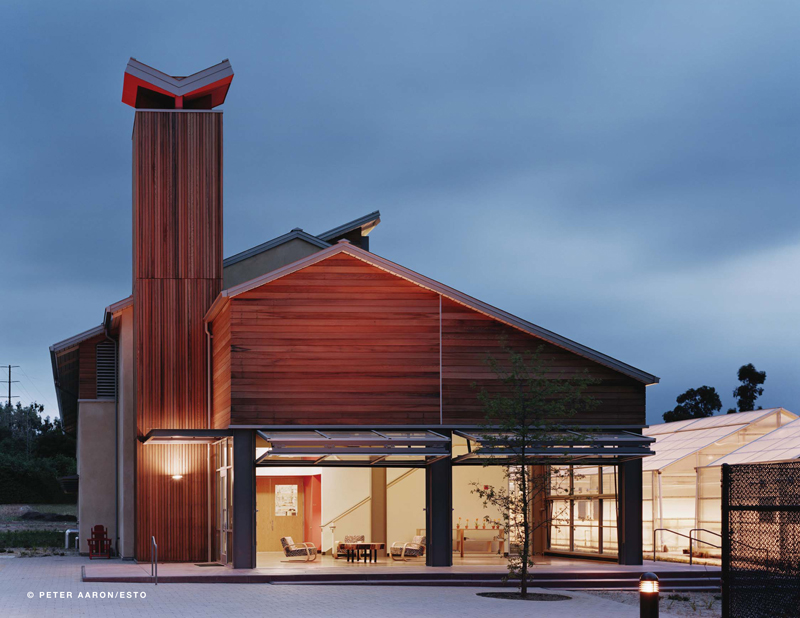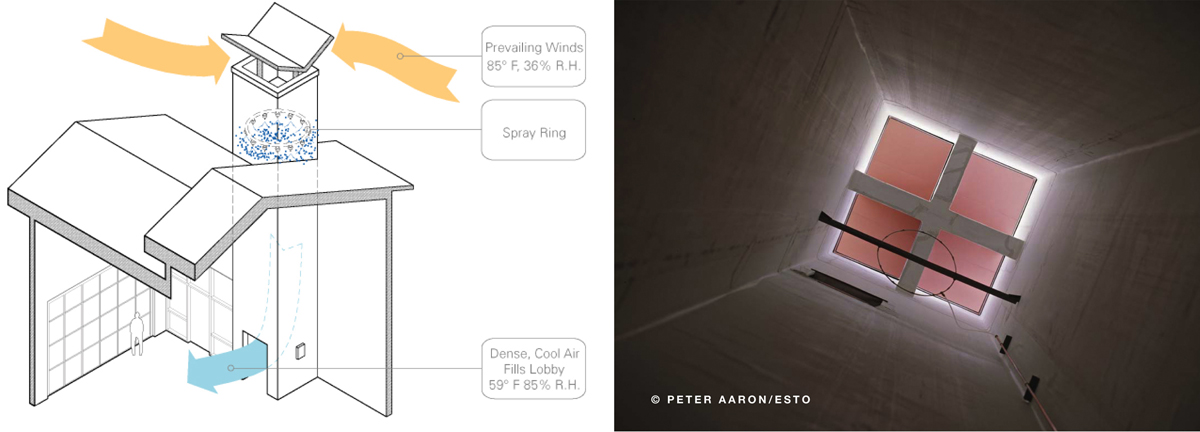Karim Elgendy
The Carnegie Center for Global Ecology in Stanford is a research facility that combines Laboratories and office spaces. The 1100 Sqm building was built on a previously developed plot of 7.4 acres. The client’s main concerns were lowering the carbon emissions tied to the building’s energy use as well as the embodied carbon emissions of building materials. Flexibility over the short and long term was also of utmost importance to the client who wanted to allow for the expansion and contraction of research teams.Like Many of the Climates of the Middle East, Stanford has an arid climate with a long dry summer season, and benefits from northwest breezes.

Image 1. View of the Eastern facade of the Carnegie Center showing the wind tower and the naturally ventilated entrance lobby. Copyright: Peter Aaron / Esto
The Design
The Design of the Carnegie Center responded to these climatic conditions with a number of passive and active design strategies. These strategies started by orienting the building along the East-West axis with sun horizontal shading provided on the southern façade.
The design team for the project, which included EHDD Architecture and Rumsey Engineers (now part of Integral), broke with the common practice of air conditioning office and laboratory facilities in the United States. The design of the building applied a mix of natural ventilation and mechanical ventilation, known as mixed mode ventilation, allowing the building to save energy on mechanical ventilation and cooling only in the spaces that need them at the times where natural ventilation was not sufficient. As a general rule, offices were naturally ventilated using operable clerestory windows and ceiling fans, and cooled using a radiant slab, while lab spaces required a higher level of ventilation and cooling and thus resorted to mechanical solutions (Figure 1).
The design also included natural ventilation of the main building lobby using a wind tower, common in traditional islamic architecture in Iran, Iraq, the United Arab Emirates, Bahrain, and Egypt ( Figure 3). The design of the tower -which was inspired by the traditional Middle Eastern design element as confirmed to us by the principal project engineer- was refined by selecting the 2 opposite inlets wind tower to respond to local wind pattern and by modifying the shape of the tower inlets to maximize the volume and speed of air drawn. The wind tower , which is known as a katabatic cooling tower, was also optimized using evaporative cooling to assist downdraft ventilation of the lobby space by spraying small water droplets through nozzles within the tower to cool the air as it comes down the tower and into the lobby. The evaporative cooling strategy is also common in traditional architecture of the Middle East both within wind towers and in the form of courtyard fountains. (Figure 2, Image 2).

Figure 1. Building section showing the different sustainable design strategies implemented. Copyright: EHDD Architecture

Figure 2. (left) is a diagram explaining the use of the wind tower. Copyright: EHDD Architecture. Image 2. (right) is a view upwards inside the wind tower showing the spray nozzles. Copyright: Peter Aaron / Esto

Figure 3. Traditional monodirectional wind tower in Cairo (left) and multi-directional wind tower in Bahrain (right)
Another application of evaporative cooling is the use of the “Night Sky” on the building roof at night. This strategy is based on the fact that the building radiates heat to the sky at night and aims to encourage this shedding of heat by spraying water on the roof. This considerably minimized the need for cooling the next morning, and reduced water since the night sky system uses 50% less water than a standard cooling chiller. (Figure 4, Image 3). The design also emphasized daylight for general building lighting using light shelves to diffuse light deep into the space. This reduced the need for artificial lighting and limited it to task lighting. (Image 4).

Figure 4. (left) A section showing the radiant slab and the "Night Sky" cooling strategies. Copyright: EHDD Architecture. Image 3. (right) Night Sky cooling
Post Occupancy Evaluation
The combination of these strategies has produced a building that not only saves on energy, and is environmentally responsible, but also provides excellent Indoor Environmental Quality to its users. In addition to winning the AIA Top 10 Green Buildings Award , a post occupancy evaluation survey (POE) of the building’s occupants showed a very high degree of satisfaction with 100% of users generally satisfied with the building and 96% satisfied with the workplace. These satisfaction results rank amongst the highest within the POE database compiled by the University of California at Berkeley, occupying the 99% percentile and the 98% percentile respectively. (Figure 5).

Figure 5. A graphical representation of the POE results relative to the CBE database. Copyright: The Center for the Built Environment, UC Berkeley
Karim Elgendy is an architect and sustainability consultant based in London. He can be contacted at: Karim [AT] Carboun [DOT] com
To discuss this article, please join Carboun’s vibrant discussion group on Linkedin. For news and updates on sustainability from around the region, join Carboun’s Facebook page or follow its Twitter feed.

